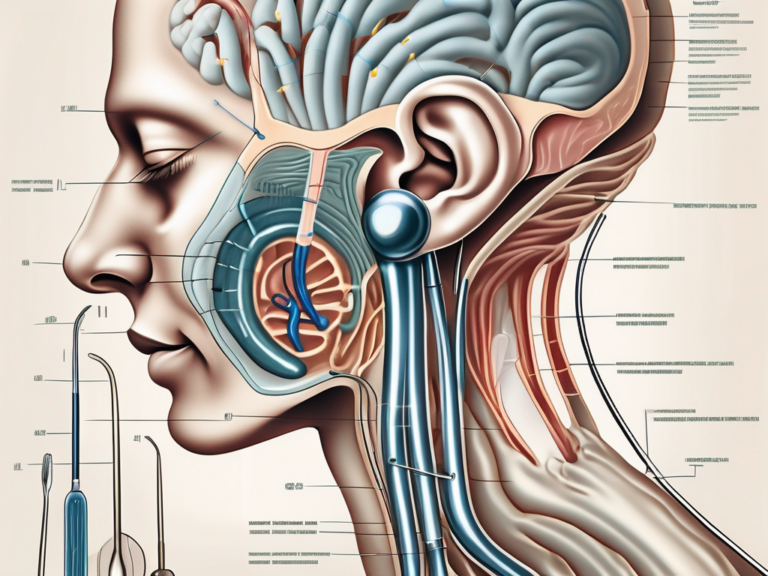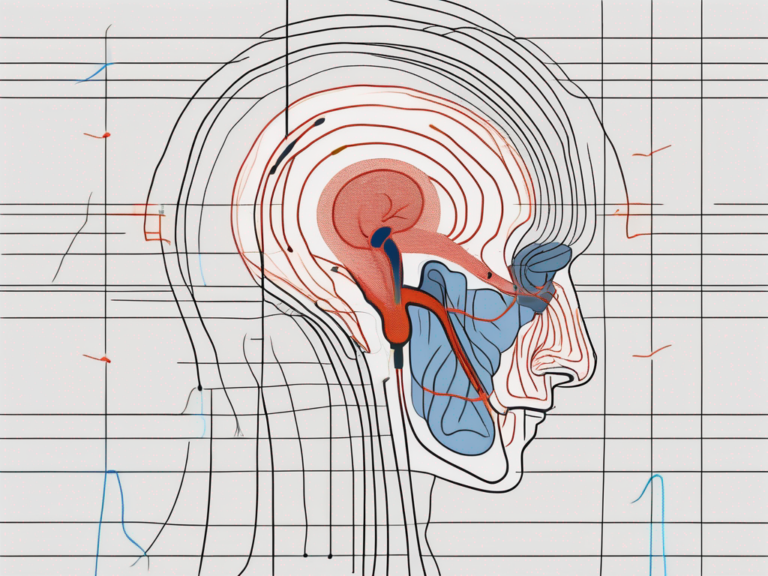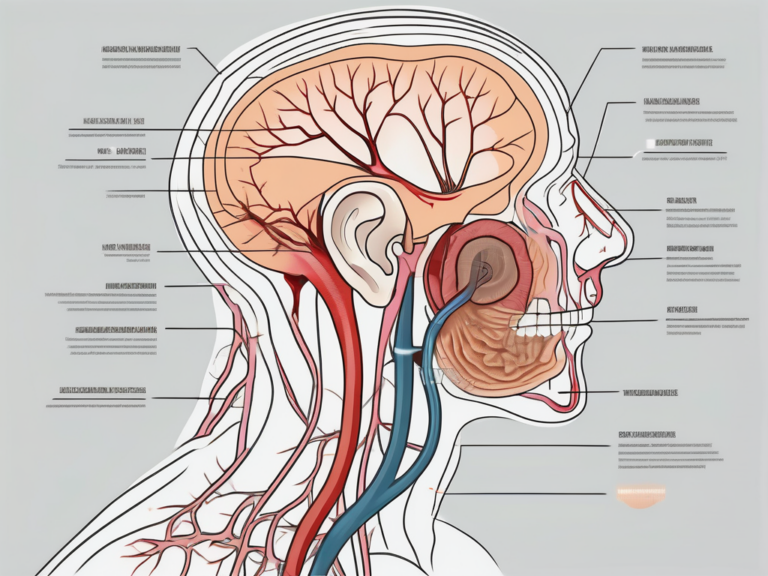The vestibular nerve plays a crucial role in our ability to maintain balance, perceive spatial orientation, and coordinate movements. This nerve carries important sensory information from the inner ear to the brain, allowing us to make sense of our surroundings. Understanding the function and anatomy of the vestibular nerve is essential for appreciating its significance in our daily lives.
Understanding the Vestibular Nerve
Anatomy of the Vestibular Nerve
The vestibular nerve is a component of the eighth cranial nerve, also known as the vestibulocochlear nerve. This nerve originates in the inner ear, specifically in a structure called the vestibular labyrinth. The labyrinth consists of the utricle, saccule, and semicircular canals, which are responsible for detecting head movements and changes in body position. The vestibular nerve arises from the hair cells, located within the utricle and saccule, and transmits signals to the brain.
The vestibular nerve consists of two branches, the superior and inferior vestibular nerves, which work together to relay sensory information to the brain. These branches extend from the inner ear and travel through the inner ear cavity before entering the brainstem.
The superior vestibular nerve primarily innervates the horizontal semicircular canal and the utricle, while the inferior vestibular nerve primarily innervates the posterior and anterior semicircular canals and the saccule. These specialized structures within the inner ear allow us to perceive and interpret various types of head movements and changes in body position.
Function of the Vestibular Nerve
The primary function of the vestibular nerve is to carry sensory impulses related to equilibrium and spatial orientation from the inner ear to the brain. When we experience head movements or changes in position, the hair cells within the vestibular system detect these changes and convert them into electrical signals. These signals are then transmitted along the vestibular nerve to the brainstem and ultimately to higher brain centers responsible for processing and interpreting this information.
By relaying this sensory information, the vestibular nerve helps us maintain balance, coordinate movements, and stabilize our gaze. It enables us to navigate our environment effectively and make precise adjustments to body position and posture.
In addition to its role in balance and spatial orientation, the vestibular nerve also plays a crucial role in our sense of motion and acceleration. When we are in a moving vehicle or on a roller coaster, the vestibular nerve detects the changes in velocity and direction, allowing us to perceive the sensation of movement.
Furthermore, the vestibular nerve contributes to our ability to adapt to different environments and situations. For example, when we step onto an uneven surface, the vestibular nerve quickly detects the change in terrain and sends signals to the brain, triggering adjustments in muscle activity to maintain stability.
In certain medical conditions, such as vestibular disorders, the vestibular nerve may malfunction, leading to symptoms like dizziness, vertigo, and impaired balance. These conditions can significantly impact a person’s quality of life and may require specialized treatment and rehabilitation to alleviate symptoms and restore normal vestibular function.
In conclusion, the vestibular nerve is a vital component of the inner ear’s vestibular system, responsible for relaying sensory information related to balance, spatial orientation, motion perception, and adaptation to different environments. Understanding the anatomy and function of the vestibular nerve helps us appreciate its role in maintaining our equilibrium and navigating the world around us.
The Journey of Impulses: From Sensation to Perception
The Role of Impulses in Sensory Perception
Sensory perception is a complex process that involves the reception, transmission, and interpretation of sensory stimuli. The vestibular nerve plays a critical role in this process by transmitting impulses from the inner ear to the brain, allowing for the perception of balance and spatial orientation.
When the hair cells in the inner ear detect changes in head position or movements, they generate electrical impulses. These impulses travel along the vestibular nerve to the brainstem, where they are integrated with impulses from other sensory systems, such as vision and proprioception. This integration allows the brain to create a comprehensive perception of our body’s position in space.
But what happens next? How does the brain process these impulses and make sense of them?
How the Brain Processes Vestibular Information
Once the impulses reach the brainstem, they are further processed and relayed to higher brain centers, including the cerebellum and cerebral cortex. The cerebellum, a structure located at the base of the brain, plays a crucial role in coordinating movement and balance. It receives and integrates vestibular information, allowing for precise coordination and adjustment of motor responses.
But the journey of these impulses doesn’t end there. They continue their path to the cerebral cortex, the outer layer of the brain responsible for higher-level cognitive functions. Here, the vestibular information is received and contributes to our conscious perception of balance and spatial orientation.
Imagine yourself standing on a tightrope, trying to maintain your balance. It is your cerebral cortex that helps you stay upright, making constant adjustments based on the vestibular information it receives. Without this integration and processing of impulses, our perception of balance and spatial orientation would be greatly impaired.
The cerebral cortex not only helps us maintain a stable posture but also allows us to navigate through space and interact with our environment effectively. It enables us to walk, run, dance, and perform all sorts of coordinated movements with ease.
So, the journey of impulses from sensation to perception is a remarkable one. From the inner ear to the brainstem, and finally to the cerebellum and cerebral cortex, these impulses undergo a series of processing and integration, ultimately shaping our conscious perception of balance and spatial orientation.
The Origin of Vestibular Impulses
Sensory Organs Involved in Vestibular Impulses
The generation of vestibular impulses begins in the sensory organs of the inner ear, primarily the utricle, saccule, and semicircular canals. These structures are filled with fluid and lined with specialized hair cells that detect changes in head movement and body position. When these hair cells are stimulated, they create electrical impulses that travel along the vestibular nerve.
But let’s dive deeper into the fascinating world of the inner ear and explore the intricate mechanisms that contribute to our sense of balance and spatial orientation.
The utricle, saccule, and semicircular canals work in harmony to provide us with a comprehensive understanding of our body’s position in space. The utricle and saccule, also known as the otolith organs, not only contain hair cells but also tiny calcium carbonate crystals called otoliths. These otoliths play a crucial role in detecting head tilt and linear acceleration. When we tilt our heads or experience linear movements, the otoliths shift, stimulating the hair cells and generating additional information about our orientation.
So, imagine a scenario where you are walking on a narrow beam. As you carefully place one foot in front of the other, your utricle, saccule, and semicircular canals are working tirelessly to provide your brain with real-time updates about your body’s position and movements.
The Pathway of Vestibular Impulses
Once vestibular impulses are generated, they travel along the vestibular nerve, which consists of the superior and inferior branches. These branches pass through the internal auditory canal, a bony canal located within the temporal bone, and enter the brainstem.
Now, let’s take a journey inside the brainstem, where the vestibular impulses continue their intricate dance. Within the brainstem, the vestibular impulses synapse with neurons in the vestibular nuclei. These nuclei serve as relay stations, processing the incoming impulses and transmitting them to various regions of the brain involved in balance control and spatial perception.
Think of the vestibular nuclei as the traffic controllers of the inner ear, directing the flow of information to different parts of the brain. From here, the processed vestibular impulses are sent to areas such as the cerebellum, which plays a vital role in coordinating movements, and the cerebral cortex, where conscious perception of balance and spatial orientation takes place.
So, the next time you find yourself effortlessly maintaining balance while walking on uneven terrain or gracefully executing a pirouette, remember that it is the result of a complex interplay between your sensory organs, nerve pathways, and brain regions dedicated to maintaining equilibrium.
Disorders Related to the Vestibular Nerve
The vestibular nerve plays a crucial role in maintaining our sense of balance and spatial orientation. When this nerve or the structures it connects with are damaged or impaired, it can result in various vestibular disorders. These disorders can have a significant impact on an individual’s daily life, causing a range of symptoms that can be both physically and emotionally challenging to manage.
Symptoms of Vestibular Disorders
One of the most common symptoms experienced by individuals with vestibular disorders is vertigo. Vertigo is a sensation of spinning or whirling, as if the world around you is in constant motion. This can be extremely disorienting and may lead to feelings of nausea and imbalance. Dizziness is another prevalent symptom, often described as a lightheaded or faint feeling.
In addition to vertigo and dizziness, individuals with vestibular disorders may also experience difficulties with coordination and spatial orientation. Simple tasks like walking or reaching for objects can become challenging and may result in unsteady movements. Visual disturbances, such as blurred vision or difficulty focusing, can also occur, further adding to the overall sense of disorientation.
It is important to note that experiencing these symptoms does not always indicate a problem with the vestibular nerve itself. Various underlying conditions, such as infections, head injuries, or certain medications, can contribute to vestibular dysfunction. Therefore, it is essential to consult with a healthcare professional for a proper diagnosis.
Treatment and Management of Vestibular Disorders
The treatment and management of vestibular disorders depend on the underlying cause and the specific symptoms experienced by the individual. In some cases, medication may be prescribed to alleviate symptoms such as dizziness or nausea. These medications work by targeting the specific mechanisms in the inner ear that are responsible for causing the symptoms.
Physical therapy and vestibular rehabilitation programs can also play a crucial role in improving balance and reducing symptoms. These programs focus on exercises and techniques that promote central compensation and adaptation, helping the brain to adjust and compensate for the vestibular dysfunction. Through targeted exercises, individuals can gradually regain their sense of balance and improve their overall quality of life.
Additionally, lifestyle modifications and self-care strategies may be recommended to manage vestibular disorders. Increasing physical activity, such as regular walking or swimming, can help improve overall strength and balance. Practicing relaxation techniques, such as deep breathing or meditation, can also help reduce stress and anxiety, which can exacerbate symptoms. It is also important to identify and avoid triggers that worsen symptoms, such as certain visual stimuli or specific head movements.
Managing vestibular disorders can be a complex and ongoing process. It is crucial to follow the guidance of a healthcare professional trained in the management of vestibular disorders to effectively address these conditions. With the right treatment and support, individuals with vestibular disorders can learn to manage their symptoms and regain control over their lives.
The Impact of the Vestibular Nerve on Balance and Spatial Orientation
The Vestibular Nerve and Balance
The vestibular nerve plays a crucial role in maintaining balance. By relaying information about head movements and body position to the brain, it enables us to make adjustments to our posture and movements. Without the vestibular nerve’s contribution, our ability to maintain balance and remain upright would be severely compromised.
Balance is a complex process that involves the integration of sensory information from multiple systems, including the vestibular, visual, and proprioceptive systems. The vestibular nerve’s contribution is particularly important when other sensory systems are compromised or when we encounter challenging environmental conditions, such as uneven surfaces or rapid movements.
Imagine walking on a narrow, winding path along the edge of a cliff. As you carefully place one foot in front of the other, your vestibular nerve is working hard to provide your brain with crucial information about your body’s position in space. It detects the slight shifts in your head and body as you navigate the treacherous terrain, allowing you to make the necessary adjustments to maintain your balance.
Not only does the vestibular nerve help us maintain balance in challenging situations, but it also contributes to our overall sense of stability and coordination. Whether we are playing sports, dancing, or simply walking down the street, the vestibular nerve is constantly providing feedback to our brain, ensuring that our movements are fluid and controlled.
Spatial Orientation and the Vestibular Nerve
In addition to balance, the vestibular nerve plays a crucial role in spatial orientation. By providing information about our body’s position in space, it allows us to navigate through our environment effectively. The integration of vestibular information with visual and proprioceptive cues helps us maintain a stable perception of the world around us.
Imagine being in a pitch-black room with no visual cues to guide you. In this situation, your vestibular nerve becomes even more important in helping you understand your spatial orientation. It provides your brain with information about your head and body movements, allowing you to make accurate judgments about your position and the location of objects in the room.
Through the vestibular nerve, our brain constructs a spatial map that guides our movements and interactions. This information not only facilitates everyday tasks such as walking and reaching for objects but also contributes to our ability to interpret and understand our surroundings.
Think about how you are able to effortlessly navigate through a crowded room without bumping into people or objects. Your vestibular nerve is constantly working behind the scenes, providing your brain with information about your body’s position and movement. This allows you to make split-second adjustments to your trajectory, ensuring that you can smoothly maneuver through the space without any mishaps.
Furthermore, the vestibular nerve also plays a role in our ability to perceive motion and acceleration. It allows us to detect changes in our body’s position and movement, whether we are in a car, on a roller coaster, or simply tilting our head. This information is crucial for our brain to accurately interpret our surroundings and maintain a stable perception of the world.
Conclusion
The vestibular nerve carries essential sensory information from the inner ear to the brain, enabling us to maintain balance, coordinate movements, and perceive spatial orientation. Understanding the anatomy, function, and significance of this nerve provides valuable insights into the complex processes underlying our ability to interact with our environment.
When experiencing symptoms related to balance or spatial orientation, it is crucial to consult with a healthcare professional for a proper evaluation and diagnosis. Vestibular disorders can significantly impact daily life, but with appropriate management and treatment, individuals can regain stability and restore their quality of life.






+ There are no comments
Add yours